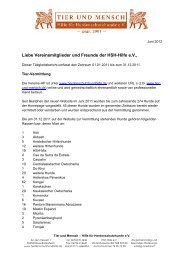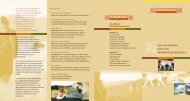FCI-Standard Nº 173 / 30.03.2009 /GB ESTRELA MOUNTAIN DOG
FCI-Standard Nº 173 / 30.03.2009 /GB ESTRELA MOUNTAIN DOG
FCI-Standard Nº 173 / 30.03.2009 /GB ESTRELA MOUNTAIN DOG
You also want an ePaper? Increase the reach of your titles
YUMPU automatically turns print PDFs into web optimized ePapers that Google loves.
2<br />
TRANSLATION : Portuguese Kennel Club. Revised by Jennifer<br />
Mulholland, Raymond Triquet and Renée Sporre-Willes<br />
ORIGIN : Portugal.<br />
DATE OF PUBLICATION OF THE ORIGINAL VALID<br />
STANDARD : 04.11.2008.<br />
UTILIZATION : A livestock guarding dog, watch dog and<br />
companion dog; also used for draught work.<br />
F.C.I. CLASSIFICATION : Group 2 Pinscher and Schnauzer,<br />
Molossoid breeds, Swiss<br />
Mountain and Cattle<br />
Dogs.<br />
Section 2.2 Molossoid breeds,<br />
Mountain type.<br />
Without working trial.<br />
BRIEF HISTORICAL SUMMARY : Since remote times, this dog<br />
has developed and settled in the Estrela Mountains area, its true<br />
origin being lost in time. Nevertheless, it can be considered one of<br />
the most ancient breeds in the Iberian Peninsula. It can be found<br />
from the foot of the mountains to the summit (approximately 2000<br />
m), mainly in the summer, after the snow has melted, when the green<br />
pastures are much sought after by the herds, because the excessive<br />
heat has dried the grass on the lowlands. The progressive recognition<br />
of its aptitudes has led to its diffusion throughout the world since the<br />
second half of the 20 th century.<br />
GENERAL APPEARANCE : Large, mastiff-type molossoid dog.<br />
There are two varieties of coat: long and short. Rustic, substantial,<br />
with brisk gait and an impressive attitude.<br />
<strong>FCI</strong>-St. N° <strong>173</strong> – <strong>30.03.2009</strong>
3<br />
The breed has a lively, calm and expressive look; it is well<br />
proportioned; well made with harmonious appearance, which is<br />
traditionally how the breed has been recognised since a long time.<br />
IMPORTANT PROPORTIONS : Moderately long (sublongilinear),<br />
tending to mediolinear. The depth of the chest is less<br />
than half the height at withers. The muzzle and skull should be<br />
approximately the same length; if not, the skull should be slightly<br />
longer.<br />
BEHAVIOUR/TEMPERAMENT : Inseparable companion of the<br />
shepherd and faithful flock guardian, bravely protecting it against<br />
predators and thieves. Wonderful farm and house guard, distrustful<br />
towards strangers and typically docile to its master.<br />
HEAD : Strong, voluminous and long and slightly convex seen in<br />
profile. Well inserted and in good proportion to the body, with the<br />
skull in proportion to the foreface; all parts in perfect harmony.<br />
Smooth skin on the skull and cheeks.<br />
CRANIAL REGION :<br />
Skull : Well developed, rounded, with slightly divergent longitudinal<br />
superior cranium-facial axes, convex profile, slightly developed<br />
superciliary arches with slightly apparent frontal furrow, occipital<br />
protuberance not prominent.<br />
Stop : Only slightly marked and at approximately equal distance to<br />
the tip of the nose and the occipital protuberance.<br />
FACIAL REGION :<br />
Nose : Straight and in line with nosebridge; well opened nostrils;<br />
large and black.<br />
Muzzle : Long, tapering to the tip, without being pointed; tends to be<br />
straight but very slightly convex at the tip.<br />
<strong>FCI</strong>-St. N° <strong>173</strong> – <strong>30.03.2009</strong>
4<br />
Lips : Well developed but not thick, well overlapping, not<br />
pendulous; mucous membrane of mouth, palate and edges of lips<br />
with intense black pigmentation.<br />
Jaws/Teeth : Clean cut mouth with well developed jaws; full<br />
dentition with strong, white, well implanted and close-fitting teeth,<br />
preferably with scissors bite, pincer bite acceptable.<br />
Eyes : Medium sized, tending to small, oval shaped, level set, equal<br />
in size and well open, with a keen and calm expression; preferably<br />
dark amber in colour. Close fitting lids with black rims. Eyebrows<br />
slightly apparent.<br />
Ears : Set on at medium height; hanging, carried falling backwards<br />
and laterally against the side of the head, with inner edge visible (so<br />
called rose-ear); thin, triangular, rounded at the tip; small in<br />
comparison to the body.<br />
NECK : Short, straight and thick; well set and well connected into<br />
the shoulders; with a slight dewlap, not exaggerated.<br />
BODY :<br />
Topline : Straight. Almost level.<br />
Back : Preferably short, well muscled.<br />
Loin : Short; broad; well muscled; well connected to the croup.<br />
Croup : Slightly sloping; short, broad and muscled. Height at croup<br />
should be equal or slightly superior to the height at the withers.<br />
Chest : Broad; deep; well sprung without being cylindrical; well let<br />
down to the elbow or slightly below it.<br />
Underline and belly : The underline should rise gradually but<br />
smoothly from sternum to the groin; belly not too wide, in<br />
proportion to the animal’s substance and harmoniously connected to<br />
the body.<br />
TAIL : Set on at medium height; long; thick; carried below the<br />
horizontal, scimitar-shaped, with a hook at the end.<br />
<strong>FCI</strong>-St. N° <strong>173</strong> – <strong>30.03.2009</strong>
5<br />
At rest it hangs naturally between the thighs, reaching at least the<br />
hock; when excited and in motion, the tail rises above the horizontal,<br />
curving upward and forward, sideways and downward, without<br />
being carried over the croup. It should be well furnished with hair,<br />
and feathered in the long-haired variety.<br />
LIMBS<br />
FOREQUARTERS :<br />
Upright with strong bone and thick joints, moderately open<br />
angulation, with easy movement.<br />
Forearms : Straight, parallel, long, with strong bone and almost<br />
cylindrical in shape.<br />
Forefeet : Proportioned, neither too round nor too long, between cat<br />
and hare feet (not splayed); thick, tight toes with abundant hair<br />
between toes and pads; dark nails, preferably black, well developed;<br />
pads thick and hard.<br />
HINDQUARTERS :<br />
Upright, strong bone with thick joints, moderately open angles, with<br />
easy movement.<br />
Hock : Slightly let down; moderately open, neither turned in nor<br />
out.<br />
Metatarsus (rear pastern) : Vertical, almost cylindrical. Possible<br />
presence of single or double dewclaws.<br />
Hind feet : Identical to the forefeet.<br />
GAIT/MOVEMENT : Sound and easy movement.<br />
COAT<br />
HAIR : Strong, very abundant, slightly coarse, without excessive<br />
harshness, the texture is similar to goat hair.<br />
<strong>FCI</strong>-St. N° <strong>173</strong> – <strong>30.03.2009</strong>
6<br />
The undercoat is composed of fine hair, short, abundant and<br />
entangled, normally lighter in colour than the outer coat.<br />
- Long-haired variety: Straight or slightly wavy top coat, uneven in<br />
some areas. It is shorter and more dense on the limbs, below the<br />
elbows and hocks, as well as on the head; on the ears, it becomes<br />
gradually shorter from the base to the tip, becoming thinner and<br />
softer. It is longer on the tail, which is bushy, thick and feathered,<br />
around the neck and throat and on the buttocks, which are<br />
abundantly feathered, as well as the back side of the forearms.<br />
- Short-haired variety: Short hair, evenly distributed over the body,<br />
slightly shorter on the head and limbs, without feathering.<br />
COLOUR :<br />
The following colours are accepted and considered typical:<br />
- Solid: yellow, fawn and grey in all ranges of colour intensity; -<br />
Wolf Grey: fawn, yellow and grey tones, commonly in lighter and<br />
darker shades.<br />
- Brindle: Fawn, yellow or grey base colour with blackish brindling.<br />
In the cranium-facial area, a dark coloured mask is typical.<br />
White markings are admitted only at the extremities of fore- and<br />
hind feet and on a small extension on the lower region of neck and<br />
chest.<br />
HEIGHT AND WEIGHT :<br />
Height at the withers:<br />
Males: 65-73 cm. Females: 62-69 cm. Tolerance: + 2 cm.<br />
Weight:<br />
Males: 45-60 Kg. Females: 35-45 Kg.<br />
FAULTS : Any departure from the foregoing points should be<br />
considered a fault and the seriousness with which the fault should be<br />
regarded should be in exact proportion to its degree and its effect on<br />
the health and welfare of the dog.<br />
<strong>FCI</strong>-St. N° <strong>173</strong> – <strong>30.03.2009</strong>
7<br />
Appearance : General bad appearance, thinness or obesity.<br />
Height : Outside the limits set by the standard, but within 2<br />
cm tolerance at the upper limit.<br />
Head : Narrow, long and pointed.<br />
Eyes : Light coloured.<br />
Ears : Incorrectly set, too long, thick or rounded tips.<br />
Hanging completely flat.<br />
Tail : Carried over the back. Absence of hook.<br />
Colour : Absence of dark mask.<br />
SEVERE FAULTS :<br />
Behaviour : Animals showing nervous unbalance with signs<br />
of shyness.<br />
Nose : Pale coloured nostrils, partly unpigmented nose.<br />
Ears : Cropped.<br />
Tail : Docked or rudimentary.<br />
Coat : Hair somewhat different from the described type.<br />
Height :<br />
Males: Under 65 cm or over 75 cm.<br />
Females: Under 62 cm or over 71 cm<br />
ELIMINATING FAULTS :<br />
Behaviour : Aggressive or overly shy.<br />
Type : Atypical.<br />
Head : Very narrow, very long and very pointed completely<br />
lacking molossoid type.<br />
Jaws : Undershot or overshot.<br />
Eyes : Wall eyes or difference in size.<br />
Tail : Anurous.<br />
Coat : Hair completely atypical.<br />
Colour : Any colour not mentioned in the standard.<br />
Albinism.<br />
<strong>FCI</strong>-St. N° <strong>173</strong> – <strong>30.03.2009</strong>
8<br />
Any dog clearly showing physical or behavioural abnormalities shall<br />
be disqualified.<br />
N.B.: Male animals should have two apparently normal testicles<br />
fully descended into the scrotum.<br />
<strong>FCI</strong>-St. N° <strong>173</strong> – <strong>30.03.2009</strong>









